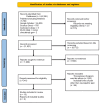Neuropharmacology of Neuropathic Pain: A Systematic Review
- PMID: 39385859
- PMCID: PMC11464095
- DOI: 10.7759/cureus.69028
Neuropharmacology of Neuropathic Pain: A Systematic Review
Abstract
Neuropathic pain, a debilitating condition, remains challenging to manage effectively. An insight into neuropharmacological mechanisms is critical for optimizing treatment strategies. This systematic review aims to evaluate the role of neuropharmacological agents based on their efficacy, involved neurotransmitters, and receptors. A manual literature search was undertaken in PubMed including Medline, Cochrane Library, Google Scholar, Plos One, Science Direct, and clinicaltrials.gov from 2013 until 2023. Out of the 13 included studies, seven evaluated the role of gabapentinoids. Two main drugs from this group, gabapentin and pregabalin, function by binding voltage-gated calcium channels, lowering neuronal hyperexcitability and pain signal transmission, thereby relieving neuropathic pain. Four of the pooled studies reported the use of tricyclic antidepressants (TCAs) including amitriptyline and nortriptyline which work by blocking the reuptake of norepinephrine and serotonin, their increased concentration is thought to be central to their analgesic effect. Three articles assessed the use of serotonin-norepinephrine reuptake inhibitors (SNRIs) and reported them as effective as the TCAs in managing neuropathic pain. They work by augmenting serotonin and norepinephrine. Three studies focused on the use of selective serotonin reuptake inhibitors (SSRIs), modulating their effect by increasing serotonin levels; however, they were reported as not a highly effective treatment option for neuropathic pain. One of the studies outlined the use of cannabinoids for neuropathic pain by binding to cannabinoid receptors with only mild adverse effects. It is concluded that gabapentinoids, TCAs, and SNRIs were reported as the most effective therapy for neuropathic pain; however, for trigeminal neuralgia, anticonvulsants like carbamazepine were considered the most effective. Opioids were considered second-line drugs for neuropathic pain as they come with adverse effects and a risk of dependence. Ongoing research is exploring novel drugs like ion channels and agents modulating pain pathways for neuropathic pain management. Our review hopes to inspire further research into patient stratification by their physiology, aiding quicker and more accurate management of neuropathic pain while minimizing inadvertent side effects.
Keywords: analgesics; nerve pain; neuropathic pain; neuropharmacology; neurotransmitters; pain modulation; peripheral neuropathy; pharmacological treatments; prisma; receptors.
Copyright © 2024, Mian et al.
Conflict of interest statement
Conflicts of interest: In compliance with the ICMJE uniform disclosure form, all authors declare the following: Payment/services info: All authors have declared that no financial support was received from any organization for the submitted work. Financial relationships: All authors have declared that they have no financial relationships at present or within the previous three years with any organizations that might have an interest in the submitted work. Other relationships: All authors have declared that there are no other relationships or activities that could appear to have influenced the submitted work.
Figures


References
-
- Individualized pharmacological treatment of neuropathic pain. Helfert SM, Reimer M, Höper J, Baron R. Clin Pharmacol Ther. 2015;97:135–142. - PubMed
Publication types
LinkOut - more resources
Full Text Sources
